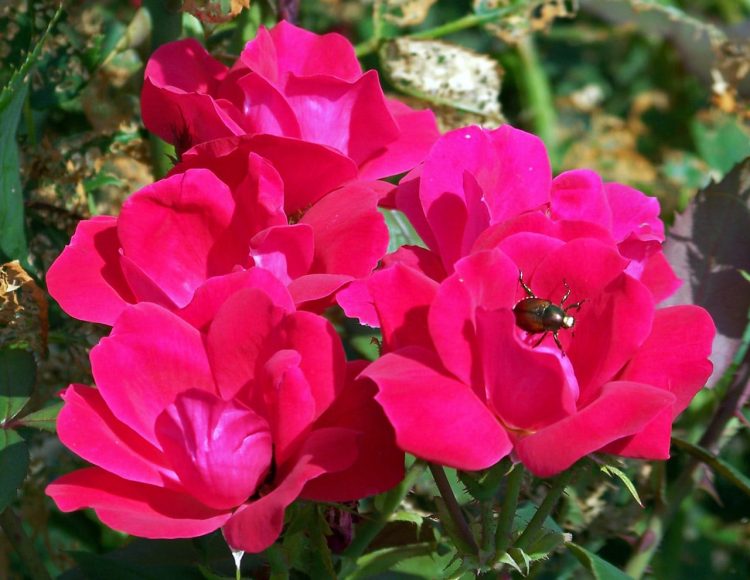You only need three steps to know how to get rid of thrips on roses. Thrips are perhaps one of the most annoying pests in houseplants, so seeing them in your beloved roses is daunting. The good news is there’s no need to fret because you can still prevent further damage and salvage your other plants.
What makes thrips a gardener’s nightmare is because they affect the plant’s physical appearance. They cause discoloration, premature dropping, and slows down the growth of the infected species. However, thrips are manageable, as you will discover in the three steps.

How To Get Rid Of Thrips On Roses: 3 Easy Steps
Step #1. Inspect roses
The first step to eradicate thrips is to inspect your roses. The control of pests is more effective if prevention always stays in your management practices. And once you notice where they are prevalent, you can make the next move, eradicating.
What are the signs of thrips infestation on roses? Distorted leaves, swollen blossoms, and discolored petals are all indications that thrips are present on the roses. According to the University of Maryland, thrips are active in June, so always check your roses this season.
You can use sticky cards above the roses to confirm your suspicion. They should effectively trap adult thrips since it’s tricky to see these tiny insects. In the greenhouse, ensure that you also maintain cleanliness such as weed removal because thrips can hide in them.
Step #2. Isolate and remove thrip damage
The most common way to control thrips is by merely removing infected plants and pruning the damaged parts. The plants themselves can stay in another area, isolated from the other plants, to prevent pests’ spread. This will help you slow down their activity and lower the population as you treat the infected roses.
It would also be best to remove thrip damage on leaves, stems, and blossoms and keep them together in a sealed plastic bag. It’s highly likely that these portions have nymphs and adult thrips, so it’s best to do this as soon as you suspect thrip infestation. However, don’t forget to practice proper sanitation, especially with the pruning shears and other materials to not bring thrips on other roses.
Step #3. Treat with insecticide
After thrip removal comes to the final step, which is treating the roses with insecticide. The greenhouse makes a suitable environment for treating plants with pests because it’s easier to apply the pesticides and target the infected parts. Still, it’s worth emphasizing the need to read the insecticide label first for you and your plant’s safety.
Many gardeners often frown at the idea of using an insecticide, but sometimes, the number of thrips get very high and hard to control. After all, using an insecticide early on means it can eradicate the thrips soon, and you can stop using chemicals much early too. And if you think about it, thrips cause damage at such a short period that using insecticides is undoubtedly the lesser evil of the two.
A systemic insecticide should work well for treating thrips on roses. You can sprinkle half a cup of it over the soil where the rosebushes are to kill the pupas on the ground. This way, you can prevent the addition of adult thrips in the days to come.
After the soil, use the insecticide on the rosebushes until the product covers the plant entirely. This is crucial to ensure that the insecticide comes in contact with all the thrips. You can then apply insecticide once a week throughout the growing season in case some thrips survive.
Controlling And Preventing Thrips On Roses
The key to pest management is always to aim to prevent having them in the first place. For example, you can grow your roses in the greenhouse to create a more controlled environment. Then, maintain cleanliness and sanitation to prevent the introduction and spread of thrips.
If you remember, step number one pertains to the inspection of roses. This is a necessary practice not only when you suspect thrips, but even as a preventative measure altogether. Make it a habit each week to check your roses, not just on thrip season.
Regular inspection will put you ahead of the thrips and control them faster. Perhaps the simple removal and pruning of infested roses would be enough, and you don’t have to use chemicals. More so, pruning regularly will help prevent thrips and is not only useful for eradication.
You can also consider adding predatory mites in the greenhouse that can feed on thrips in the early stages. If the infection is not that severe, but you see thrip damage, neem oil makes an excellent solution before immediately trying insecticides.
Conclusion
Even roses are not safe against pests. If you notice discolored petals, distorted leaves, and swollen blossoms, you might need to learn how to get rid of thrips on roses as soon as possible. Start by inspecting the roses and removing thrip damage.
The greenhouse makes these steps easier because of space, but make sure to have another area for isolating infected plants. Depending on the severity, you might get away with pruning away the infected parts, using neem oil, or adding predatory insects. However, systemic insecticide would be the best choice if the population is hard to control.
